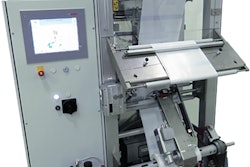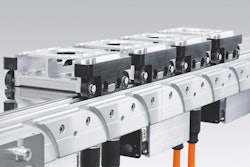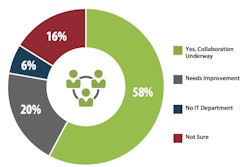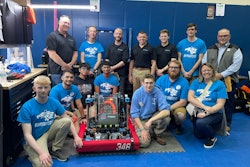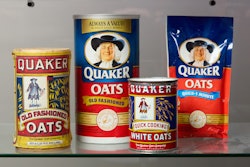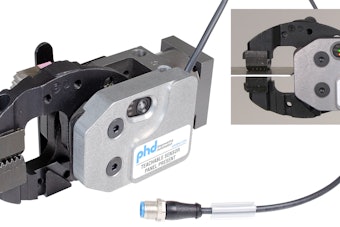
As successful manufacturing enterprises in Northeastern and Midwestern steel towns and metropoles have grown through and beyond the 20th century, many have undergone a sort of forced migration. Spatial limitations and a host of other factors have slowly marched them out of the city center and into fresh greenfield locations, sometimes in neighboring states, so production could expand.
But family-owned Triangle Package Machinery Company, founded in 1923 by then-copacker Louis Muskat, has long been a city stalwart. Now known for high end vf/f/s baggers among other machines, the company grew from co-packing origins into a full-fledged machine builder, with all of the spatial demands that status historically entailed. But it had been able to incrementally expand the footprint of its current Chicago facility, acquired in the 1950s, over time to accommodate growth and long-standing customer relationships without moving.
But in 2015, after more than 90 years in business, customer demand, particularly due to the explosion in flexible packaging, was reaching a breakneck pace. Meanwhile, the facility had finally gone as far as it could go in terms of size, and the surrounding neighborhood had finally landlocked the space at 100,000 sq. ft. Third generation president Bryan Muskat was faced with a dilemma, and a hard one given that 82 percent of his employees lived within 12 miles of the facility. He knew he had to find a way to manage incoming business and shorten lead times, while retaining long-standing employees and attracting fresh faces.
“We have highly skilled people,” Bryan Muskat says. “We felt it would just be too disruptive to take our business and even move 15 to 20 miles away, much less farther out. We’ve hired a number of young, excellent engineers who live in the city and like working in the city. Being located in Chicago is a big draw to prospective talent and our current employees.”
Bryan Muskat believes that at Triangle, it all comes down to the people. The OEM takes pride in being family-owned for generations and aims to create a long term relationship with its employees that makes them feel like extended family. So, moving the facility out of the city and away from its employees was out of the question.
Luckily, Triangle had weathered and out-lasted the era in manufacturing in which suburban migration was the only practical choice. Of course, there are lots of other factors at play beyond sheer square footage. But today, Triangle can take advantage of the advent of lean and other efficiency-minded technologies that allow OEMs to do more with less.
Approaching the company’s 95th year anniversary, the family’s third generation of leadership made the strategic decision to reinvest in itself and its location to fully modernize its facility’s competencies. With a more than $2 million capital outlay, it was able to improve its technological edge and shorten lead times without risking its workforce or giving up its attractive city address.
Leaning inward instead of building outward
With the help of a team member with a vision—Graham Turrell, director of operations—Triangle leveraged fresh automation and lean manufacturing practices to optimize and increase production capacity.In truth, the company had already started its lean enterprise journey in 2007 by incorporating Kaizen events, implementing 5S workspaces, and training and recruiting new talent to replace retirees.
“I conducted meetings with all of our employees to get the buy-in, because when you talk about lean, people start thinking headcount reduction,” Bryan Muskat says. “In our presentation to the employees, we guaranteed that no jobs would be cut because of the implementation of lean.”
But more recently, the team, including Turrell, Bryan Muskat, and David Muskat, VP–manufacturing technology, found new ways to lean out operations by phasing out legacy technology and equipment with newer practices and tech innovations.
Keeping it all under one roof
A couple of years before the decision to reinvest was made, Turrell recognized that there was a generational movement of older machine shop operators that were going to retire. And conveniently, the OEM’s legacy equipment was wearing down at a similar clip.“I made a proposal that we had quite elderly machine shop equipment here, and this would be a great opportunity to move new technology into the facility, allow people to retire, and not necessarily have to replace them,” Turrell says.
Triangle doesn’t have plants in other countries, or even elsewhere in the U.S., which allows the company to achieve maximum inventory turnover. But to keep from outsourcing parts, David Muskat conducted a thorough search of potential machining solutions. Ultimately, his efforts led the company to invest $2 million into Mazak machine tools, and hire a new machine shop foreman who had experience with lean and high-speed tooling.
“The foreman found that we weren’t even operating our new Mazak equipment to its full potential,” David Muskat says. “Implementing high-speed tooling in the machine shop was a new experience for us and has been an on-going journey. But as we implemented these machines, the cost payback was quick, because we were cutting our manufacturing time down by 50 percent. The machines double our capacity, and allow us to make more parts within hours.”
As the company spins the Mazak machines up into full production, the team is already looking at how it can lean out the more artisanal, people-powered side of parts manufacture—the fabrication.
“How do you make welding lean? Sheet metal bending on press brakes, or other skilled jobs? We have one machine where we grind all of the welds down to a high finish, and it could take as long as 40 hours,” says Bryan Muskat. “But part of our lean process is figuring out how we can reduce the time of that grinding. We tried many things, including moving the machine to a different welder who didn’t put on much weld, and that reduced the time.”
Since the company has fully embraced and implemented lean, Muskat says it’s important to always ask, “Why does this process take so long, and how can it be better?” So this lean approach is also being applied to more artisan areas of the shop where there isn’t as much technology available in the market to improve efficiency.
Another core tenet of lean is the constant war against bottlenecks. To eliminate them, Triangle would have to create a better process to find out where and when they were showing up. This is where the big data-capabilities of an all new Enterprise Resource Planning (ERP) system came in.
New ERP system refreshes work flow
Few single decisions can have as much of a positive impact on streamlining a manufacturer as adopting an appropriate ERP system. Triangle was able to improve on efficiency without cutting jobs by implementing Microsoft Dynamics (NAV) to replace the OEM’s legacy ERP system. But ERP implementation wasn’t without a few false starts. In fact, the company had attempted to implement an ERP six years ago, but when that didn’t work, it pulled the plug, took its losses, and moved on. This time around, in 2017, the company hired Jim Gio, manager, information systems, to find, implement, and run a new ERP system that would be right for Triangle.“The information that Jim can glean from the ERP is amazing,” says Tim Gasparich, CFO. “We didn’t have information about wait times at work centers, for example. How long did it take for a part to make it to the next work center along its path? How long did it stay there before it moved along? That gives the production department an idea where the bottlenecks are.”
One of the biggest pros Gio saw coming out of NAV was having a true understanding of what Triangle’s financials looked like. When comparing systems, Gio liked that Microsoft Dynamics NAV was flexible, but at the same time, strict with data flow and input requirements.
“On my end of the business, I won’t allow us to work around the system,” Gio says. “If the system is not designed to do it, we have to ask ourselves, ‘Why are we doing it that way, and what is the purpose of this?’ Because the system has a lot of capabilities, it makes it easier for us to say, ‘Reevaluate your processes. What are you doing here, and why are you doing it?’ If NAV can’t do it, should we be doing it?”
The strict guidelines also help Gio and other Triangle employees to keep track of aging orders at each work center.
“With the old system, if we had 10 production orders, the team would work on one, but there would be one at the bottom that kept getting older and older by the day. But now, I can create graphs that show me what’s aging at a work center, and then I can zoom in and prioritize,” Gio says.
The new ERP system will also help the company achieve its long-term goal of lowering lead times from 16 weeks to 12 weeks, Bryan Muskat says.
Turrell envisions using the ERP system to not only find and eliminate these sorts of bottlenecks, but to also offer employees and management live data on how each work cell is preforming.
“To use that data as live information to see if the team is over-or under-performing, compared to the standard, would be very useful,” Turrell says. “In fact, I have a temporary employee looking over the last six months of three key work centers to see actuals versus standard. He hasn’t collected all the data yet, but we want to see where we sit. Does industrial engineering underestimate the time that it takes somebody to make a bracket? And if so, that’s valuable for us to know.”
From push to pull
Triangle has long been a vertically-integrated enterprise, so the increased capacity with new machine tools’ production capability has been a boon. And with the new ERP system implemented, Triangle has been able to transition its parts machining and manufacturing format from push to pull. Instead of making parts in batches based on inexact forecasts, virtually all machined components are based on a sold machine—a confirmed, signed order. This all but eliminated component inventory, freeing space and adding capacity to machine tools. So instead of building parts for hypothetical future machines, machine tool capacity is focused on the next order, thus eating away at lead time.“This technology is going to move us to a new paradigm as far as efficient manufacturing in the factory,” Turrell says. “We only make what we sell on a single site. It’s about as simple as it gets. So, if it’s an economic order quantity (EOQ) of one, then it’s an EOQ of one. The next phase of this implementation is to make it as automated as possible so that everybody that’s interacting with a component is truly adding value to it.”
Triangle’s long-standing relationship with its metal materials supplier allows the OEM to get materials within two to three days of the order so it doesn’t have to stock material inventory, either. Also, by adopting a “made-to-order” model, the OEM has almost completely eliminated rework.
“There’s a friction going on in the facility about the minimum that a machine tool should make of a certain part, which is great. And that decision is now made by the factory supervisor’s managers, not by the planning department,” Turrell says. “Planning used to say, ‘When we make that part, then we’re going to make 15 of them,’ based on little information. Whereas the supervisor of that machine tool, he knows what is an efficient use of quantity management within that. So that’s a big change we made.”
R&D lab aids in shorter lead times
This year, Triangle created an R&D lab and separated the department from the core applications design group to allow it to focus more on new product development.“Engineering and R&D have always been in one department, but we finally realized that there is so much interference and noise with applications that we felt that it would be better to separate them,” Bryan Muskat says. “We brought a programmer into the department so that when solutions were being created, they were mechanically and electrically designed at the same time to reduce lead times.”
Triangle invests seven percent of its annual sales into R&D, and has embarked on multiple projects with its customers.
“We’ve been big in the zipper side of the industry, and putting the zippers on the packaging,” says Paul Muskat, VP–business development. “That was driven by one of our customers who had a zipper applicator that they purchased from ITW, and they asked us if we could integrate it into our machine. That way we control it. It has the same look and feel as a Triangle machine, and we were able to reduce the footprint outside the machine itself.”
Growing sales through the reinvestment
So what sparked all of this reinvestment? Triangle has been riding its reputation, long-standing customer relationships, and the flexible packaging revolution into sales growth. The way Triangle develops solutions ends up being the number one driving force behind this growth, says Ralph Hernandez, VP–sales and marketing.“We’re not out there with a push strategy,” he says. “We’re being pulled by our key customers and what their needs are. We keep investing in R&D to develop new products, such as the ultrasonic seal.”
While the sales department is being pulled by industry trends and customer demands, it was the sales volume that drove the company to reinvest in new equipment.
“As the market evolved, we began doing more to support our customers,” Hernandez says. “And essentially what happened in the shop is a result of our increase in sales. If you don’t compress its lead time, and you keep increasing volume, then your lead time gets pushed out.”
Triangle’s sales department keeps its focus on the package style most widely-used by its customers and trying to figure out how to create efficient solutions for each of the package types.
“We’re not out there saying, ‘Hey, we’re going to make this package style. You guys sell this.’ It’s about listening to the customer who wants ultrasonic seals or the customer that wants to reduce six people from their case packing line,” adds Paul Muskat.
The future is happening now
The OEM is paving its future with its recent investment into its facility, new equipment, and technology. It has taken aim at $50 million in annual revenue in the coming years, and is building in more lean concepts and practices to keep up with its growing business, rather than expanding the facility.“We may look a little tight space-wise, but this place is dark at night,” Turrell says. “We have one shift and a small second shift. This could easily be a three-shift facility, open 24 hours a day. There’s a lot more growth that we can do without outgrowing the building.”
For Triangle, the motto is people, process, and technology, which is why this investment has not only been important for the company’s growth, but also to its employees.
“This investment that we’re making in equipment makes a statement to our employees that we’re here for the long haul,” Gasparich says. “We’re looking for the next generation. We’re getting set up. That’s a comfort factor to them, to know that we’re going to be here.”
